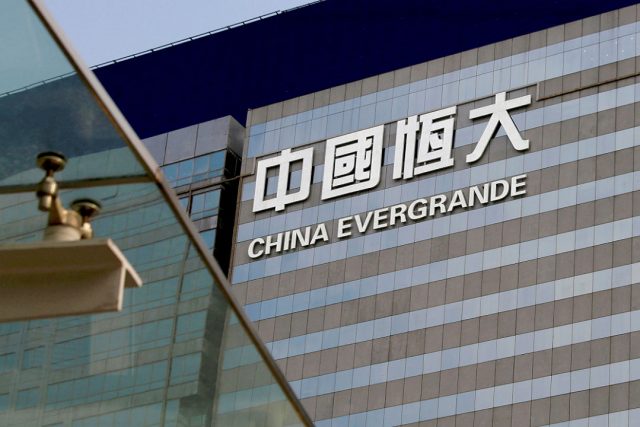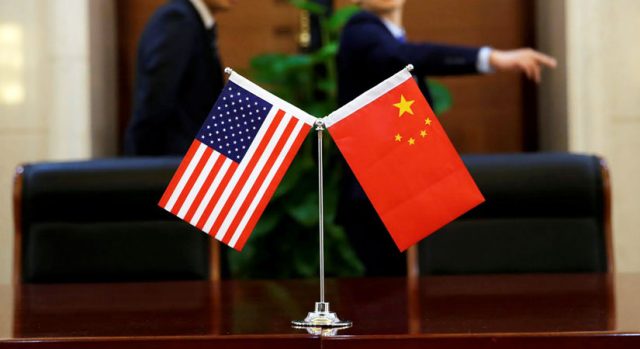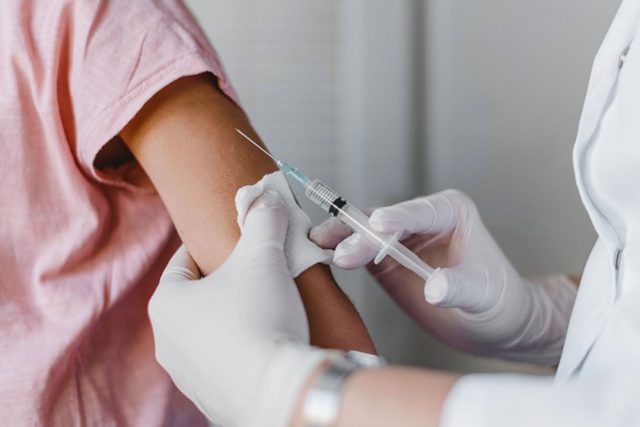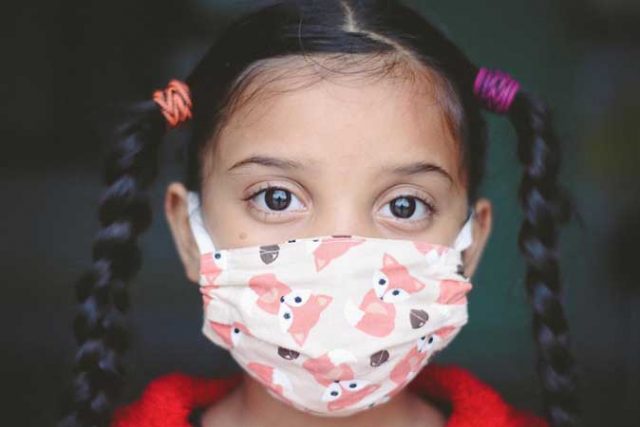Evergrande dodges default again but sector debt concerns remain
SINGAPORE/HONG KONG — Cash-strapped developer China Evergrande Group averted a destabilizing default at the last minute for the third time in the past month, with a source on Thursday saying several bondholders had received overdue coupon payments.
Evergrande, the world’s most indebted developer, has been stumbling from deadline to deadline in recent weeks as it grapples with more than $300 billion in liabilities, $19 billion of which are international market bonds.
Chinese media outlet Cailianshe reported several bondholders have received interest payments of the three bond tranches that had a total of more than $148 million due last month.
The payments were made at the end of a 30-day grace period that ended Wednesday, as was the case with two separate offshore coupon payments that were due in late September and for which the grace periods ended late last month.
A failure to pay would have resulted in a formal default by the company and triggered cross-default provisions for other Evergrande dollar bonds, exacerbating a debt crisis looming over the world’s second-largest economy that has rattled global markets.
“The near-term fix seems to be happening but there’s a long way to go before this issue gets sorted out. These are early days,” said the source with knowledge of the matter, referring to Evergrande and declining to be named without authorization to talk to the media.
Evergrande, which is at the center of a deepening liquidity squeeze in China’s $5 trillion property sector, did not respond to Reuters request for comment on its latest bond coupon payment.
Although the developer managed to avoid a default again, woes in the property sector showed no signs of abating with a wall of debt coming due.
Evergrande has coupon payments totaling more than $255 million due on Dec. 28. It has come under pressure from its other creditors at home and a stifling funding squeeze has cast a shadow over hundreds of its residential projects.
Investor focus is now also shifting to other cash-strapped developers which have a string of offshore payments coming due in the short term, including Kaisa Group.
Kaisa has the most offshore debt of any Chinese developer after Evergrande and pleaded for help from creditors this week. It has coupon payments totaling over $59 million due on Thursday and Friday.
Kaisa, which became China’s first property company to default on an overseas bond in 2015, has already missed payments on some wealth management products at home.
The developer did not immediately respond to Reuters request for comment.
HARD LANDING
While the US Federal Reserve this week warned China’s troubled property sector could pose global risks, there were no clear indications whether Beijing will step in with a broader, national plan to tackle the issue.
Chinese regulators have in recent weeks, however, sought to reassure investors and homebuyers, saying risks were controllable and excessive credit tightening by banks was being corrected.
Regulators and government think tanks have also held meetings with developers in the past few weeks, and the market is expecting some easing in credit and housing policies to prevent a hard landing of the sector.
Those hopes and Evergrande’s payment sparked a relief rally across Chinese property shares, with an index of real estate A-shares surging nearly 8%, and Hong Kong’s Hang Seng Mainland Properties Index trading up more than 3%.
Shares of Evergrande listed in Hong Kong rose 5.5% at noon.
Chinese developers’ bond prices, which have been hit hard in recent weeks, soared even higher.
Duration Finance data showed the price on China Aoyuan Group’s 5.88% March 2027 bond jumping more than 30% on the day, although it continued to trade at deeply distressed levels of around 36 cents in the dollar.
Bonds issued by Times China Holdings Xinyuan Real Estate, Yuzhou Group Holdings and Sunac China Holdings also rose more than 10%.
An index of dollar-denominated Asian high-yield bonds rose more than 1%, while Chinese high-yield corporate dollar spreads narrowed from record highs. — Anshuman Daga, Clare Jim and Andrew Galbraith/Reuters
Fintech startup gives OFWs control over how remittances are spent
Beam & Go, a local fintech startup, gives overseas Filipino workers (OFWs) control over their remittances by allowing them to specify how much money should go to a specific purpose, such as shopping for groceries.
Its platform forwards a unique gift code to the chosen beneficiary, allowing them to spend the amount for the designated purpose.
Over 4,000 OFWs and their families have managed household finances and purchased goods, medicines, and school supplies through the startup’s solution.
“[Our] platform addresses the issue of remittance leakage and empowers their families to better manage their finances and make responsible spending decisions for the household,” said founder Jonathan E. Chua.
Beam & Go’s online marketplace contains various categories, including supermarket e-vouchers; food padala (restaurant vouchers); mobile load; medicines; and livelihood packages, such as reselling refillable (liquefied petroleum gas) canisters and stoves from Gaz Lite.
Among the vendors in its marketplace are Super8 in Luzon, Prince Hypermart in the Visayas, Gaisano Mall in Mindanao, and nationwide establishments such as Generika pharmacy and Mayani.ph fresh goods delivery.
“Over the years, we heard tales of abusive employers and scam artists, broken marriages and truant children, and mounting debt that never goes away. It made us angry,” Mr. Chua added.
It reaches its target users through referral programs, Facebook community groups among OFWs in different countries, and partnerships with foreign domestic worker agencies, non-profits, and other remittance services.
The startup also created Project SEGUIDA, a financial and social management tool for OFW spouses, children, and other beneficiaries.
Beam & Go’s OFW clients are from Singapore, Hong Kong, Japan, Taiwan, Saudi Arabia, and the United Arab Emirates. Many of them are the sole breadwinners, and belong to families with four children.
The fintech start-up received equity-free investment and technical and business mentorship under the 2020 Fintech for Impact program of Dutch multinational ING Bank and UNICEF (the United Nations Children’s Fund). — Patricia B. Mirasol
China’s Xi warns against return to Cold War tensions at APEC meeting
WELLINGTON — The Asia-Pacific region must not return to the tensions of the Cold War era, Chinese President Xi Jinping said on Thursday, ahead of a virtual meeting with US President Joseph R. Biden, Jr., expected as soon as next week.
Mr. Xi, in a recorded video message to a CEO forum on the sidelines of the Asia-Pacific Economic Cooperation (APEC) summit hosted by New Zealand, said attempts to draw ideological lines or form small circles on geopolitical grounds were bound to fail.
“The Asia-Pacific region cannot and should not relapse into the confrontation and division of the Cold War era,” Mr. Xi said.
Mr. Xi’s remarks were an apparent reference to US efforts with regional allies and partners including the Quad grouping with India, Japan and Australia, to blunt what they see as China’s growing coercive economic and military influence.
China’s military said on Tuesday it conducted a combat readiness patrol in the direction of the Taiwan Strait, after its Defense Ministry condemned a visit by a US congressional delegation to Taiwan, the democratically governed island claimed by Beijing.
Combative US diplomatic exchanges with China early in the Biden administration unnerved allies, and US officials believe direct engagement with Mr. Xi is the best way to prevent the relationship between the world’s two biggest economies from spiraling toward conflict.
A date has not been announced for the Xi-Biden meeting, but a person briefed on the matter said it was expected to be as soon as next week.
The week-long annual forum, culminating in a meeting of leaders from all 21 APEC economies on Friday, is being conducted entirely online by hosts New Zealand, a country with hardline pandemic control measures that has kept its borders closed to almost all travelers for 18 months.
Mr. Xi has only appeared by video, and has not left China in about 21 months as the country pursues a zero-tolerance policy towards COVID-19. The Chinese president is also participating this week in a meeting of the ruling Communist Party that is expected to further cement his authority.
Mr. Xi said emerging from the shadow of the pandemic and achieving steady economic recovery was the most pressing task for the region, and that countries must close the COVID-19 immunization gap.
“We should translate the consensus that vaccines are a global public good into concrete actions to ensure their fair and equitable distribution,” Mr. Xi said.
APEC members pledged at a special meeting in June to expand sharing and manufacturing of COVID-19 vaccines and lift trade barriers for medicines.
TRADE DEALS
Taiwan’s bid to join a regional trade pact, the Comprehensive and Progressive Agreement for Trans-Pacific Partnership (CPTPP), is expected raise tensions at the APEC leaders’ meeting later in the week.
China, which has also applied to join CPTPP, opposes Taiwan’s membership and has increased military activities near the island which Beijing claims.
The United States pulled out of CPTPP under former President Donald Trump. A 15-nation regional trade pact backed by China, the Regional Comprehensive Partnership Agreement (RCEP), will also take effect from Jan. 1.
Mr. Xi said in the lead-up to RCEP implementation and CPTPP negotiations that China would “shorten the negative list on foreign investment, promote all-round opening up of its agricultural and manufacturing sectors, expand the opening of the service sector and treat domestic and foreign businesses as equals in accordance with law.”
The United States has offered to host APEC in 2023 for the first time in over a decade as President Joe Biden turns resources and attention to the Asia-Pacific following the withdrawal of US forces from Afghanistan.
However, no consensus has yet been reached among APEC members on the offer.
CLIMATE CHANGE
Climate change has been a key item on the agenda at the summit, which is taking place in parallel with the United Nations’ COP26 meeting in Glasgow.
Mr. Xi said China would achieve its carbon neutrality targets within the time frame it has set and its carbon reduction action would require massive investment.
New Zealand Prime Minister Jacinda Ardern said in her opening address that APEC had taken steps to wean the region’s industries off fossil-fuel subsidies. — Praveen Menon and Shashwat Awasthi/Reuters
‘Thoughtless’ flaw on DFA website leaves thousands vulnerable to phishing attacks — cybersecurity expert
By Patricia B. Mirasol
(On Nov. 12, Foreign Affairs Assistant Secretary Eduardo R. Meñez said via text message: “Contrary to allegations, DFA does not utilize a program such as Microsoft Excel to store passport applicants’ data. The public is assured that their data is encrypted and stored in a highly-secure and complex database.”)
***
Thousands of passport applicants are vulnerable to phishing attacks due to data privacy issues discovered on Nov. 9 in the online passport tracker of the Department of Foreign Affairs (DFA).
“Identity theft may lead to social engineering attacks,” said Dax L. Labrador, founder of ROOTCON, the largest hacking conference in the Philippines. “To combat this, be vigilant for any suspicious call, SMS [text], and/or email as you are now a soft target of social engineering attacks.”
He added that saving a massive amount of personal information, including mobile numbers and full names, on a flat spreadsheet was “a very thoughtless approach” on the DFA’s part.
Flat files, which store a single record per line, are “less secure than their relational counterparts” according to cybersecurity experts.
Continued Mr. Labrador: “The best implementation would have been to record such data on a secure database server, giving access to queries only coming from legitimate sources.”
In a Nov. 10 press statement, the DFA announced that it had taken down the Online Passport Tracker and all its data sources to avoid further data broadcasting.
Its IT (information technology) unit, the agency said, is “currently investigating the circumstances surrounding this issue and is taking appropriate measures to secure the data that may have been exposed. An internal audit will also be conducted to prevent similar incidents from happening in the future.”
According to Mr. Labrador, organizations should take a proactive approach to stress-testing their online facilities instead of being reactive.
Proactive organizations hold preventive prelaunch risk exposure assessments, including a code review and VAPT (vulnerability assessment and penetration testing, which addresses cybersecurity vulnerabilities).
Reactive organizations, meanwhile, are ticking time bombs waiting to blow up.
‘INGAT MUNA’
The flaw in the DFA’s passport tracking system flaw was brought to the attention of BusinessWorld on Nov. 9 by a DevOps (or development and operations) specialist from a private firm who requested anonymity.
“Ingat muna [Take care]. I already reported this to the DFA,” said the DevOps specialist on Tuesday. “Meron mas malala dyan [There’s something worse]; they can see your mobile numbers too.”
The data, together with the full names of each passport applicant, were accessible through the said government agency’s online passport tracking system, which is still offline as of press time.
Using secure API (application programming interface) endpoints, according to the DevOps specialist, can help the DFA better manage its sensitive data. APIs are access points that allow applications to communicate with one another.
“Make use of session locking. Make it hard for people to brute force the system on queries,” he told BusinessWorld in a LinkedIn message. Brute force involves guessing different password combinations until the right one is hit.
This is not the first data privacy concern faced by the DFA.
In 2019, the National Privacy Commission (NPC) conducted an investigation on the agency’s assertion that a former contractor made off with passport data after its contract was terminated.
Rivian valued at over $100B in debut, after world’s biggest IPO of 2021
Shares of Rivian Automotive Inc. surged as much as 53% in its Nasdaq debut on Wednesday, giving the Amazon-backed electric vehicle (EV) maker a market valuation of more than $100 billion after the world’s biggest initial public offering this year.
Rivian shares closed at $100.73, marking a nearly 30% jump from its offering price.
That made Rivian the second most valuable US automaker after Tesla Inc, which is worth $1.06 trillion. Despite just having started selling vehicles and having little revenue to report, Rivian ranked ahead of General Motors Co. at $86.05 billion, Ford Motor Co. at $77.37 billion, and Lucid Group at $65.96 billion.
Rivian also has trouble ramping up production in Illinois as supply-chain constraints have hit automakers globally. Last July, the EV maker said COVID-19 and its impact on suppliers had delayed the launch of vehicles out of Illinois.
Since last year, EV companies have emerged as some of the hottest investments. Including securities such as options and restricted stock units, Rivian’s fully diluted valuation exceeded $106 billion at its debut price.
The IPO allowed Rivian to raise about $12 billion to fund growth, and that figure could rise to $13.7 billion if the full over-allotment of shares is exercised. This makes it the biggest U.S. IPO since Alibaba Group Holding Ltd went public in September 2014.
“The transition to a public company [and] the growth in our capital base” enables Rivian to develop “promising products and volume and growth in terms of new segments and new vehicles that we’ll be going into,” Rivian Chief Executive R.J. Scaringe said in an interview.
Wall Street’s biggest institutional investors, including T. Rowe Price and BlackRock, are betting on Rivian to be the next big player in a sector dominated by Tesla Inc amid mounting pressure on automakers in China and Europe to eliminate vehicle emissions.
Amazon.com Inc is Rivian’s largest shareholder with a 20% stake.
Rivian’s IPO comes against the backdrop of the United Nations Climate Summit, where automakers, airlines and governments unveiled a raft of pledges to cut greenhouse gas emissions from global transport.
GM CEO Mary Barra on Wednesday said Rivian’s IPO only showed how undervalued her company is.
“What it highlights to me is the huge opportunity,” she said at a New York Times event. “General Motors is so undervalued.”
EXPANSION PLANS
Rivian has been investing heavily to boost production, doubling down on its upscale all-electric R1T pickup truck launched in September. It plans to follow that with an SUV and delivery van, hitting some of the hottest segments in the market.
The Irvine, California-based company plans to build at least one million vehicles a year by the end of the decade, Scaringe said. It has a plant in Illinois, and has announced plans to open a second US factory and eventually setting up production in China and Europe.
“Rivian is in the early stages of delivering its first vehicles to customers, which tells investors the company and vehicles are ‘real’ and not merely pictures in a slide deck,” D.A. Davidson & Co analyst Michael Shlisky said. “This has been an issue with other EV companies in recent months.”
On Wednesday, 10 environmental and advocacy groups, including Sierra Club and Greenpeace, urged Rivian to engage with labor unions as the company grows. Workers at Rivian’s plant in Illinois are not unionized.
Founded in 2009 as Mainstream Motors by Mr. Scaringe, the company was renamed in 2011 as Rivian, a name derived from “Indian River” in Florida, a place Mr. Scaringe frequented in a rowboat as a youth.
Mr. Scaringe will hold all outstanding Class B common shares after the IPO and get 10 votes per share, Rivian said in a filing.
Rivian, also backed by Ford, priced an upsized IPO of 153 million shares at $78 per share, raising nearly $12 billion, making it one of the biggest U.S. IPOs of all time. Ford declined to reveal plans for its Rivian stake of about 12%, which was worth about $10 billion on Wednesday.
Amazon, T. Rowe Price, Franklin Templeton, Capital Research and Blackstone are among a group of “cornerstone investors” which are indicated to buy up to $5 billion worth of shares, according to the filing.
Rivian’s shares were also offered to retail investors on Social Finance Inc (SoFi).
Morgan Stanley, Goldman Sachs and J.P. Morgan were the lead underwriters for the offering. — Noor Zainab Hussain and Ben Klayman/Reuters
US and China unveil emissions deal in bid to save UN climate talks
GLASGOW — The United States and China, the world’s two largest emitters of carbon dioxide, unveiled a deal to ramp up cooperation tackling climate change, including by cutting methane emissions, phasing out coal consumption, and protecting forests.
US climate envoy John Kerry and his Chinese counterpart Xie Zhenhua announced the framework agreement at the United Nations (UN) climate conference in Scotland. Both billed it as a way to tip the summit toward success.
Earlier, the head of the UN conference noted that climate commitments so far in the talks would do too little to tame global warming and urged countries to “get to work” over the remaining two days.
“Together we set out our support for a successful COP26, including certain elements which will promote ambition,” Mr. Kerry told a news conference about the deal between Washington and Beijing. “Every step matters right now and we have a long journey ahead of us.”
Speaking through an interpreter, Mr. Xie told reporters the deal would see China strengthen its emissions-cutting targets. “Both sides will work jointly and with other parties to ensure a successful COP26 and to facilitate an outcome that is both ambitious and balanced,” Mr. Xie said.
The joint declaration said China would begin phasing out its coal consumption during the five years from 2026–30 and would cut emissions of the powerful greenhouse gas methane.
Until the announcement, observers at the climate talks had worried that Chinese President Xi Jinping was not attending in person and Beijing had made no substantial new pledges beyond its previous target to achieve carbon neutrality before 2060. China’s climate plan also had not addressed its large methane emissions, linked largely to its sprawling coal industry.
Securing the deal was a political victory for US President Joseph R. Biden, Jr., who sought to restore Washington’s leadership on climate after former President Donald Trump withdrew from a global pact to combat it.
To land the agreement, Washington sidelined some disputes with Beijing, including humanitarian issues like treatment of China’s ethnic Uighurs.
“We’re honest about the differences. We certainly know what they are and we’ve articulated them,” Mr. Kerry told reporters. “But that’s not my lane here. My job is to be the climate guy and stay focused on trying to move the climate agenda forward.”
EU climate policy chief Frans Timmermans told Reuters the US-China agreement gave room for hope.
“It’s really encouraging to see that those countries that were at odds in so many areas have found common ground on what is the biggest challenge humanity faces today,” he said. “And it certainly helps us here at COP to come to an agreement.”
Durwood Zaelke, president of the Institute for Governance and Sustainable Development, agreed.
“The US-China agreement is the breakthrough that should set the tone for wrapping an ambitious COP,” he said.
AMBITION GAP
A first draft of the COP26 deal, released earlier in the day, had received a mixed response from climate activists and experts. The draft implicitly acknowledged that current pledges were insufficient to avert climate catastrophe, asking countries to “revisit and strengthen” by the end of next year their targets to reduce greenhouse gas emissions up to 2030.
The next two days of negotiations were still likely to be fierce. The goal is to keep alive hopes of capping global temperatures at 1.5 degrees Celsius (2.7 Fahrenheit) above pre-industrial levels, which remained far out of reach given current pledges to cut emissions.
That aspirational target was set at the landmark 2015 Paris accord. Since then, scientific evidence has grown that crossing the 1.5C threshold would unleash significantly worse sea level rises, floods, droughts, wildfires and storms than those already occurring, with irreversible consequences.
On Tuesday, the Climate Action Tracker research group said all national pledges submitted so far to cut greenhouse gases by 2030 would, if fulfilled, allow the Earth’s temperature to rise 2.4C by 2100.
Greenpeace dismissed the draft as an inadequate response to the climate crisis, calling it “a polite request that countries maybe, possibly, do more next year.”
Some developed countries pointed the finger at major polluters such as China, India and Russia. Most poorer nations accused the rich world of failing to keep promises of financial help for them to deal with the ravages of climate change.
As delegations locked horns over wording of the final statement, another Glasgow pledge saw a group of countries, companies and cities committing to phase out fossil-fuel vehicles by 2040.
On Wednesday, the conference also secured agreements from countries and companies to slash emissions from the transport sector, which accounts for nearly a quarter of global human-caused greenhouse gas emissions.
The final text from the COP26 meeting will not be legally binding, but will carry the political weight of the nearly 200 countries that signed the Paris Agreement.
WHO PAYS?
At the moment, the draft dodges poorer countries’ demands for assurances that rich nations provide far more money to help them curb their emissions and cope with consequences of rising temperatures.
It “urges” developed countries to “urgently scale up” aid to help poorer ones adapt to climate change, and calls for more funding through grants rather than loans, which burden poor nations with more debt.
But it does not include a new plan for delivering that money, and climate-vulnerable island states said they would push in final negotiations for clearer commitments.
“The level of ambition required to keep 1.5 within reach is not reflected yet in the finance texts,” Sonam Phuntsho Wangdi, who chairs the least developed countries group, told the conference.
Poor countries are seeking tougher rules for future funding, after rich nations failed to meet a 2009 pledge to provide $100 billion a year in climate finance by 2020, and now expect to deliver it three years late. — Jake Spring and Valerie Volcovici/Reuters
Lockdown love: dating during the pandemic
Over the pandemic, the youth have taken to online dating platforms to look for what [or who] they need to make life bearable during lockdown.
On these apps, users can put their best foot forward and operate outside traditional gender norms.
“Anything that happens in one part of your life usually has a ripple effect in other parts of your life. We are not separate components. We are an integrated being,” said Dr. Margarita Go-Singco Holmes, a clinical psychologist specializing in sex therapy, in panel discussion organized by dating app Bumble.
“If you are assertive in one aspect of your life, it will push you to be assertive in other aspects of your life,” she added.
Bumble, launched in 2014 and brought to the Philippines in 2019, was created by Whitney Wolfe Herd, one of the co-founders of dating and social app Tinder.
Heralded as a solution for the misogyny rampant in online dating, what set the new app apart were the settings that gave women the responsibility to make the first move.
Since Bumble was founded, women have made the first move on the app over 2 billion times around the world, said Lucille McCart, communications director for Bumble in Asia Pacific.
“We’re social creatures. We want to engage and connect. We want to meet people,” she said. “The video feature was luckily something we had before then [the pandemic]. We saw over 50% increase of video calls made in the app between March and May last year.”
Independent journalist Ana P. Santos echoed this sentiment and shared from personal experience that Filipinos are now more accepting of the online dating scene.
“The Philippines keeps topping the world’s list of top internet users, … that’s where we’re meeting people,” she said. “Another evolution is that women aren’t waiting to be chosen but making an active choice, taking charge of their own love life.”
WHAT FILIPINO WOMEN WANT
Bumble has added filters and information on a person’s bio such as height, work, gender identity, political stand, and interests to make the dating process more convenient.
“The research has told us that Filipinos prioritize personality over any other aspect when looking for a partner,” shared Ms. McCart. “When creating your profile, show off your personality. Show off what’s important to you.”
Dr. Holmes agreed, adding features in Bumble such as audio notes and video calls are essential in helping people get to know each other better on the app: “It’s backed up by research to go through these channels before actually meeting. Studies have shown that tone of voice matters and this is one way that people respond. Sometimes, just hearing the tone of voice makes you decide whether you want to meet or not.”
Meanwhile, Ms. Santos reassured those who suffer from dating fatigue.
“Dating fatigue is real,” she said. “If you want to go off the app for whatever reason, that’s normal, and if you want to go back to it again, it’s part of a cycle you’re going through in life.”
As a tip for those struggling to pursue their matches and stay motivated to engage in conversations, the panelists encouraged setting aside time for the app instead of logging on impulsively and without intention. “Keep your self-concept intact,” they said. — Brontë H. Lacsamana
World at risk of measles outbreaks as COVID-19 disrupts infant shots, report says
The risk of measles outbreaks is high after more than 22 million infants missed their first vaccine doses during the COVID-19 pandemic in 2020, the World Health Organization (WHO) and the US Centers for Disease Control and Prevention (CDC) warned.
Reported measles cases fell by more than 80% last year compared with 2019, but a higher number of children missing their vaccine doses leaves them vulnerable, a joint report by the WHO and the US CDC showed on Wednesday.
About 3 million more children missed the shots in 2020 than the previous year, the largest increase in two decades, threatening global efforts to eventually eradicate the highly infectious viral disease.
“Large numbers of unvaccinated children, outbreaks of measles, and disease detection and diagnostics diverted to support COVID-19 responses are factors that increase the likelihood of measles-related deaths and serious complications in children,” the US CDC’s immunization head, Kevin Cain, said.
Measles is one of the most contagious diseases known, more so than COVID-19, Ebola, tuberculosis or flu. It can be especially dangerous for babies and young children, with pneumonia among the possible complications.
In 2019, reported cases of measles were at their highest in almost a quarter of a century.
The latest report said 24 measles vaccination campaigns originally planned for 2020 in 23 countries were postponed, leaving more than 93 million people at risk.
“It’s critical that countries vaccinate as quickly as possible against COVID-19, but this requires new resources so that it does not come at the cost of essential immunization programs,” said Dr. Kate O’Brien, director of the WHO’s department of immunization, vaccines and biologicals.
“Routine immunization must be protected and strengthened; otherwise, we risk trading one deadly disease for another,” she said. — Reuters
Philippines hinges tourism revival on South Korea, returnees
The Philippines is banking on its returning citizens and a planned travel bubble with South Korea to revive its pandemic-hit tourism sector, Tourism Secretary Bernadette Romulo-Puyat said on Thursday, as the Southeast Asian country remains closed to visitors.
It is in talks with its top market South Korea to welcome tourists on board chartered flights, Puyat said in an interview with Bloomberg TV’s David Ingles. The two countries are ironing out quarantine requirements for these tourists upon return to South Korea, she said.
The Philippines also plans to further ease quarantine rules for returning citizens who can also help boost domestic travel, Puyat said. Domestic tourism, which has driven the sector even pre-pandemic, has shown signs of revival, with travelers from the capital now visiting tourist spots as movement curbs are eased and vaccines are rolled out, she said.
Lagging its neighbors in easing travel curbs, the Philippines remained at the bottom of Bloomberg’s Covid Resilience Ranking last month as infections declined across the region. Thailand and Indonesia have reopened tourist spots to foreign visitors, while Malaysia and Singapore will soon allow quarantine-free entry for the fully-vaccinated. — Bloomberg
How to help your child get the most protection out of their face mask
With many children around the country required to wear masks in classrooms, including those as young as eight in Victoria, Australia, parents are wondering how they can support their kids’ mask use.
Schools are a breeding ground for respiratory viruses. When a large number of people are gathered together for extended periods of time within indoor areas, it’s a perfect recipe for aerosol transmission.
Along with proper ventilation, physical distancing and good hygiene, face masks can help reduce the spread of coronavirus disease 2019 (COVID-19).
So what masks are best for kids? And how can children increase the likelihood their mask will protect them from COVID?
The dominant route for COVID transmission is through the inhalation of infectious aerosols. When someone with COVID coughs, sneezes, talks or even breathes, they are exhaling scores of tiny virus-laden particles into the air that others around them can breathe in.
Evidence from the United States shows wearing masks in classrooms may reduce the chance of children contracting COVID from their classmates. Regions with school mask mandates have roughly half the rates of COVID infection among children than those without.
While randomized clinical studies focusing on mask use in schools are not available, data from larger community mask use trials support their ability to reduce the number of symptomatic COVID cases in the community.
The World Health Organization recommends mask use in students 12 years or older, and in students from six to 11 years old under appropriate supervision.
Masks don’t impact the air exchange in children or their ability to breathe, so they’re safe to use. However, masking students with specific needs should be evaluated on a case-by-case basis.
Mask use in children aged five and younger is not recommended, in part because facial expressions are important for social and emotional learning.
When selecting a mask, pay close attention to the fit; a mask will lose much of its effectiveness if it’s not worn appropriately. There shouldn’t be any gaps around the nose or along the sides of the face.
While many masks are capable of preventing the release of large droplets in those who are infected, a tighter fit will improve the filtration of the smaller aerosol particles.
Of the available mask varieties, N95 or P2 types have the best filtration efficiency, capturing more than 95% of particles. Though they need to be tested to ensure a proper fit to be most effective, and they may prove uncomfortable when worn for long periods.
Surgical masks (the disposable kind you can buy at supermarkets and pharmacies) are the next best at filtration, with efficiencies from 50–75%.
Surgical mask efficiency can be improved if a tighter fit is created around the face, such as by wearing the surgical mask underneath a cloth mask, or through the “knot & tuck” method.
While useful for older students, N95s and most surgical masks may not be as effective in protecting young children, as many of these masks were designed for adults.
Cloth varieties, on the other hand, usually fit children much better. Being able to use fun prints and colors can help kids feel more comfortable with mask-wearing.
However, single-layer cloth masks are typically not recommended due to their low filtration efficiency. Well-fitting triple-layered masks are much better, and they are as effective as surgical varieties.
The recommendations for children’s mask use mirror those for adults, so:
- try to avoid touching the outside of the mask. This means using the ear loops to put on and remove the mask. If the mask is doing its job effectively, there could be virus particles on the outside of the mask. Always wash or sanitise hands after touching the mask
- use a separate bag for storage. It’s important that a mask does not contaminate or be contaminated by other items
- ensure the mask covers both the mouth and nose
- wash cloth masks after every use. It may help to have several cloth masks so a fresh one can be used daily
- throw out surgical and N95 masks after each use
- don’t use a mask with valves. These won’t prevent an infected person spreading the virus.
While the advice might feel relatively complicated, research shows that even children in the first two years of school are very compliant with mask guidelines, using them appropriately for 77% of the school day, on average.
For best results, instructions on mask use and safety are needed alongside the rollout of masks in schools.
The use of masks is less important during outside recess and breaks, because outdoor areas are generally well-ventilated.
In indoor areas where masks can’t be used, such as during lunch, physical distancing is encouraged. — The Conversation
This article is republished from The Conversation. Read the original article.
Lighting solutions to consider for every commercial space
Lighting is one of the most essential elements when decorating a business space. It can help set the tone and mood that will beautifully radiate within the whole area and achieve every business owner’s interior design goals. Whether it be formal lighting for offices or rustic-looking for restaurants and other smaller businesses, the right lighting can go a long way in providing you the visual appeal as well as the functionality you’d want to get. So, here are the types of lighting solutions from Alphalux that you can consider for different kinds of commercial spaces:
- Hanging lights for outdoor dining area
Hanging lights offer a subtle yet creative way to add value to your outdoor dining spaces. It can give off a homer and an interesting feel that can uplift the whole ambiance of the place. Aside from its timeless aesthetic, hanging lights also offer additional safety within the area especially during nighttime.

- Chandeliers for hotel lobbies
Lobbies are an essential part of any hotel. It is a multi-functional space where they receive guests and also where people can relax and chat. Install a flashy and majestic chandelier at the center of the lobby to set an opulent tone for the rest of the space. This will help achieve an inviting ambiance where guests can feel safe and welcomed.

- Table lamps and sconces at hotel rooms

Just like any other room, hotel rooms need to have a sense of comfort where guests can get the rest that they need. Place table lamps or sconces on each side of the bed to incorporate a warm and homier vibe around the rooms. These types of lighting can also provide a sufficient source of light for guests who prefer to sleep with the lights on without causing eye irritation.

- Pendant lamps for coffee shops
Pendant lights are a must-have decorative piece in coffee shops. They provide a fancy yet versatile option that can be styled alone or layered in different heights. This type of lighting comes in a variety of designs, shapes, and finishes that allow you to create a unique design that suits your taste and needs.

- A resort’s post lamps
Post lamps bring out a dramatic take in lighting fixtures. It helps intensify and add visual value to a landscape making it a great lighting option for resorts. Post lamps are also made to withstand rough weather conditions while sophisticatedly illuminating pathways and open spaces.

- Recessed downlights in office spaces
Recessed downlights offer equal amounts of illumination and give off a wider-looking space, perfect for office areas. It is also a space-saving lighting option with a minimally elegant design. If you have a low ceiling office space, recessed lighting is a top-notch choice.

- Ceiling lamps in banquet halls
Wide and open spaces like banquet halls require an adequate amount of lighting to brighten the whole space. Opt for ceiling lamps that offer sufficient brightness while also having polished-looking designs. Ceiling lamps provide a quick aesthetic upgrade perfect for spaces used for formal events.

- Spotlight for mini boutiques
If you have limited space in your business area like boutiques, spotlights make an excellent lighting option. These are adjustable, neat-looking, and offer focused lighting perfect for a more dramatic feel around your boutique. Spotlights can also serve as an accent light for items you want to highlight.

Choose the right lighting fixture and brighten up your business space with Alphalux, exclusively from Wilcon Depot. Visit any of their 71 Wilcon stores nationwide or shop online at Wilcon Online Store by visiting shop.wilcon.com.ph.
Explore the limitless product selections that Wilcon offers, ranging from Tiles, Sanitarywares, Plumbing, Furniture, Home Interior, Houseware, Outdoor Living, Building Materials, Hardware, Electrical, Appliances, Tools, Automotives, Paints & Sundries, and other DIY items.
To ensure a safe and convenient shopping environment in all Wilcon stores, the company continuously implements safety protocols for the health and well-being of both employees and valued customers.
You can also shop through your Personal Shopper with the Browse, Call, and Collect/Deliver service. For the list of participating stores with their pick-up and delivery contact details, click this link: www.wilcon.com.ph/content/328-bcc-branches.
Another shopping alternative is the Wilcon Virtual Tour. An online shopping option wherein customers can contact the nearest Wilcon store via Facebook Messenger App. Customers can contact the nearest stores, and the Wilcon team will take you on a virtual tour where you can explore the available products inside their physical stores.
Wilcon also provides contactless payment options to its customers like bank transfers, GCash, PayMaya, InstaPay, PesoNet, WeChat, and Alipay for customers’ convenience.
For more information about Wilcon, you can log on to www.wilcon.com.ph or follow their social media accounts on Facebook and Instagram. Subscribe and connect with them on Viber Community, LinkedIn, and YouTube.
Spotlight is BusinessWorld’s sponsored section that allows advertisers to amplify their brand and connect with BusinessWorld’s audience by enabling them to publish their stories directly on the BusinessWorld Web site. For more information, send an email to online@bworldonline.com.
Join us on Viber to get more updates from BusinessWorld: https://bit.ly/3hv6bLA.













